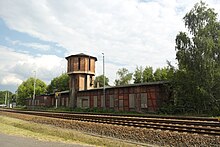Wittstock depot (Dosse)
The Wittstock (Dosse) railway depot (or Bw Wittstock (Dosse) for short ) was used for the maintenance, repair and provision of steam locomotives and later diesel locomotives that were stationed in Wittstock or circulated there. It is located in Wittstock (Dosse) train station in its eastern area on the south side of the track system. It was put into operation in 1885 and was independent until the end of 1970. In 1971 the former depot came to the Wittenberge depot as an operational site and continued to operate until the end of 1997.
The remaining parts of the former depot are entered in Wittstock's official list of monuments.
history
On March 10, 1885, the Prignitzer Eisenbahn-Gesellschaft began transporting goods on the railway from Wittenberge to Wittstock. A workshop was set up on the southeast side of the train station in Wittstock for the locomotives used. It consisted of a two-track engine shed, a water tower, a workshop and treatment facilities.
With the opening of the line to Buschhof and Neuruppin in 1895, the importance of the depot in Wittstock increased considerably. In 1912, the Ruppin Railway also opened the line to Freyenstein and used the Wittstock depot to supply the locomotives used.
Due to this increased importance, the Prignitzer Eisenbahn-Gesellschaft built an eight-track roundhouse with a turntable in front. The old rectangular shed was then converted into a workshop with a boiler shop. A little later, a double-track wagon shed was added and an extension with office and social rooms was added at the end of the 1930s. With the nationalization of the Prignitzer Eisenbahn, the depot was transferred to the Deutsche Reichsbahn on January 1, 1941 and was assigned to the Reichsbahndirektion Schwerin .
From January 1, 1971, the Reichsbahndirektion Schwerin converted the depot into an operational site and made it subordinate to the depot Wittenberge. After the fall of the Berlin Wall, the importance of the place of action decreased further and further. On January 1, 1996 it came to the Schwerin depot and was finally closed completely on December 31, 1997. After many years of decline, the city bought the area in 2015 and planned to use it again. In April 2019 it was announced that the wood-based materials manufacturer Swiss Krono will set up a creative center there.
Locomotive inventory
During the Second World War, locomotives of the series 75 6 , 89 9 , 91 2 , 93 16 and 86 operated in Wittstock. After the Second World War, the 64 series took over passenger train service. For freight train service, on the other hand, locomotives of the class 93 0-4 were stationed in Wittstock.
At the end of the 1960s, the traction change also began in Wittstock . From 1968 V 60 12 were used for shunting service. In the same year locomotives of the class 50 and later the class 50 40 replaced the class 93 0-4 in freight train service. From 1971, the Deutsche Reichsbahn replaced the class 64 with class 110 diesel locomotives . In 1978 the 57 10-35 series was briefly used .
The steam traction finally came to an end in Wittstock when the class 50 35 was decommissioned in 1987. As a replacement for the steam locomotives, vehicles of the classes 105/106 2-9 , 110/112, 111 and 171/172 were available.
Job sites
From 1941, the Perleberg and Pritzwalk deployment sites were part of the Bw . After a short period of employment, Perleberg went to the Wittenberge depot in 1948. It was followed in 1970 with the conversion of the Wittstock depot into a deployment site and the Pritzwalk deployment site.
See also
literature
- Klaus-Jürgen Kühne: Railway depots in the GDR . transpress Verlag, page 2017, ISBN 978-3-613-71549-3 , page 141.
Web links
Individual evidence
- ↑ Official List of Monuments Ostprignitz-Ruppin. (As of December 31, 2018), accessed on November 24, 2019.
- ↑ Swiss Krono expands to Wittstock. Märkische Allgemeine , published on April 10, 2019, accessed on November 24, 2019.
Coordinates: 53 ° 9 ′ 36.3 " N , 12 ° 28 ′ 51.4" E
